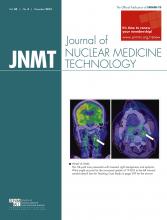Abstract
We present a case of a 59-y-old woman who had undergone cholecystectomy and was subsequently found to have an abscess within the gallbladder fossa. A hepatobiliary scan using 99mTc-diisopropyliminodiacetic acid demonstrated the characteristic rim sign, a photopenic defect surrounded by a rim of mildly increased activity immediately adjacent to the gallbladder fossa. The rim sign was thought to be the result of reactive inflammation in the hepatic tissue adjacent to a postoperative abscess within the gallbladder fossa.
Hepatobiliary scintigraphy is a reliable noninvasive technique for the detection of postoperative bile leakage as well as other hepatobiliary disease. Visualization of the rim sign on hepatobiliary scintigraphy is a fairly specific finding for acute cholecystitis. Here, we present a case of postoperative abscess within the gallbladder fossa after cholecystectomy, resulting in the rim sign.
CASE REPORT
A 59-y-old woman with a remote history of gastric bypass unsuccessfully underwent endoscopic retrograde cholangiopancreatography for suspected choledocholithiasis, followed by placement of a percutaneous cholecystostomy drain and subsequent cholecystectomy. Twenty-four days postoperatively, the patient was seen in her primary care physician’s office and had persistent leukocytosis despite absence of abdominal pain or systemic symptoms. An ultrasound done the same day revealed pneumobilia, a common bile duct measuring 1.3 cm, and dilated intrahepatic and pancreatic ducts. Abdominal and pelvic CT performed with contrast material at an outside hospital showed a thick-walled, heterogeneous, complex fluid collection within the gallbladder fossa that also contained small pockets of air (Fig. 1). The finding was thought to represent either a biloma or an abscess. Hepatobiliary scintigraphy was ordered to rule out the possibility of bile leakage, and images were obtained every 2 min after intravenous injection of 188.7 MBq (5.1 mCi) of 99mTc-diisopropyliminodiacetic acid. The scan showed no evidence of biloma; however, a photopenic defect surrounded by a rim of mildly increased activity within the liver immediately adjacent to the gallbladder fossa was seen (Fig. 2), increasing the suspicion that an abscess was present. Percutaneous aspiration of the abscess revealed Enterococcus faecalis, a microbe commonly found in the lower gastrointestinal tract.
Axial (A and B) and reformatted coronal (C) CT images demonstrating abscess in gallbladder fossa with adjacent surgical clips.
Hepatobiliary scintigraphy images at 20 min (A), 30 min (B), and 60 min (C). Rim sign is indicated by arrows.
DISCUSSION
Although hepatobiliary scintigraphy is typically used to evaluate disease or postprocedural iatrogenic injury of the biliary tree and gallbladder (1), it may also demonstrate any abnormality in hepatic parenchymal tissue. In the rim sign, a photopenic area in the gallbladder fossa does not show any filling with radiotracer and is surrounded by increased activity in the pericholecystic area. This sign is seen in approximately 32% of patients with acute cholecystitis and has a positive predictive value of 94% when seen in conjunction with nonvisualization of the gallbladder (2). The sign occurs secondary to several mechanisms such as increased blood flow and extraction of radiotracer by the liver, as well as decreased clearance from edema and inflammation of biliary canaliculi leading to bile stasis (3).
Because the rim sign is typically associated with a more emergent clinical picture, the importance of obtaining a proper patient history and correlative imaging cannot be underestimated. In our case, for example, if the patient had been septic and unresponsive, if the medical history had been unavailable, and if the interpreter had considered the scintigraphic findings in isolation, a case of acute cholecystitis may have erroneously been diagnosed. This diagnosis would, of course, have been impossible because of the prior cholecystectomy, leaving bile leakage or hepatic abscess to be the much more likely possibilities in the differential diagnosis. On abdominal CT, a surgical clip was seen at the proximal cystic duct, hinting not only that a prior surgical procedure was performed but also that the gallbladder fossa contained air, thus making abscess the more probable diagnosis.
CONCLUSION
Because the rim sign is not unique to acute cholecystitis and may be seen in hepatic abscess (4) or chronic cholecystitis as well (5), it is reasonable to believe that an abscess in the gallbladder fossa would cause reactive inflammatory findings in the adjacent hepatic tissue similar to the findings for an emphysematous or gangrenous gallbladder.
DISCLOSURE
No potential conflict of interest relevant to this article was reported.
Footnotes
Published online Jun. 25, 2015.
REFERENCES
- Received for publication February 9, 2015.
- Accepted for publication April 28, 2015.









